Coins of the wars between Rome and Persia, page 2.
(Go to the first page about coins that refer to wars between Rome and Persia).
Trajan, 98-117
 Trajan, 98-117
Trajan, 98-117
Sestertius. 33 mm. 20.07 grams.
Trajan seated right on high platform on left, raising right hand while addressing the soldiers, one with a horse, to his right.
IMPERATOR VIIII / SC below.
This sestertius does not mention Parthia explicitly, but it does mention "IMPERATOR VIIII" which modern scholars have determined refers to his capture of Singara.
RIC 658. Sear II 3187.
(Return to the first page.)
Lucius Verus, 161-169.
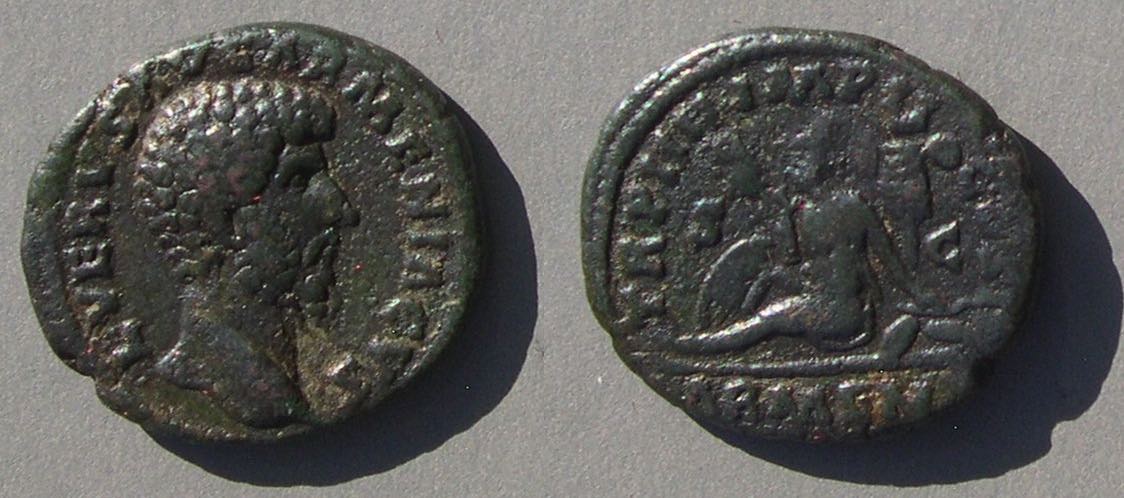 Lucius Verus, 161-169
Lucius Verus, 161-169
As. 26-23 mm.
This is the same design as the "ARMEN" denarius on the main page, but on a copper as.
L VERVS AVG ARMENIACVS
This clearly states his conquest of Armenia which was a necesssary precursor to invading Parthia.
TRP IIII IMP II COS II
ARMEN in exergue.
Personified Armenia seated mourning before pile of arms and standard
"TRP IIII" dates this coin to Dec. 163 - Dec. 164
RIC 1364. Sear II 5407.
Marcus Aurelius, 161-180, shared the victory types of Lucius Verus.
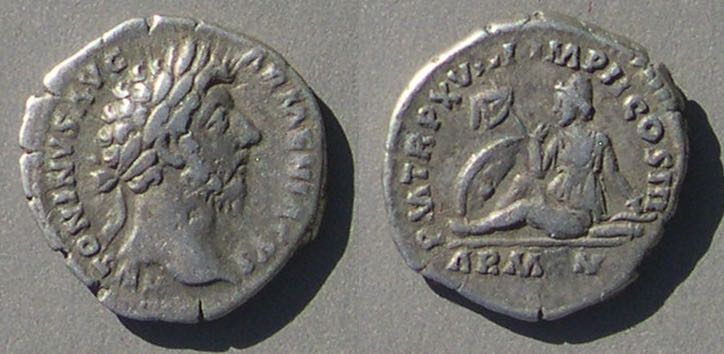
Marcus Aurelius, 161-180.
Denarius. 17 mm.
ANTONINVS AVG ARMENIACVS
Head right, laureate
PM TRP XVIII IMP II COS III
Personified Armenia seated mourning before pile of arms and standard
ARMEN in exergue.
RIC 81. Sear II 4881.
Struck Dec. 163- Dec. 164.
(Return to the main page.)
Septimus Severus had many types celebrating victories against Parthia.
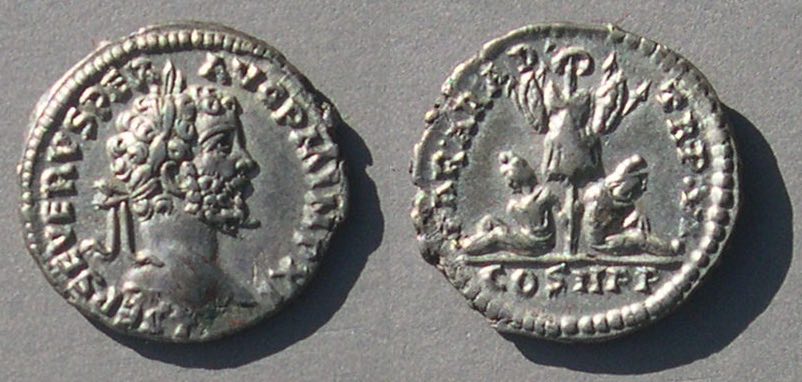 Septimius Severus, 193-211
Septimius Severus, 193-211
18 mm. 2.78 grams.
The obverse of this coin records "IMP XI", that is, 11 notable victories of Septimius.The reverse has
PAR AR AD TRP VI COS II PP
(Parthians, Arabs, and Adiabenes)
"TRP VI" dates the coin to 198.
RIC 496. Sear II --, but would follow 6322. BMC 627.
Reference works like BMC Roman, volume 5, discuss which victories go with which IMP numbers. They say IMP XI was for the fall of Ctesiphon 198 [BMC cxxvi]. At this time he took the title "PART MAX" which appears on his coins later (two and three coins down).
(Return to the type of Septimius Severus on the main page.)
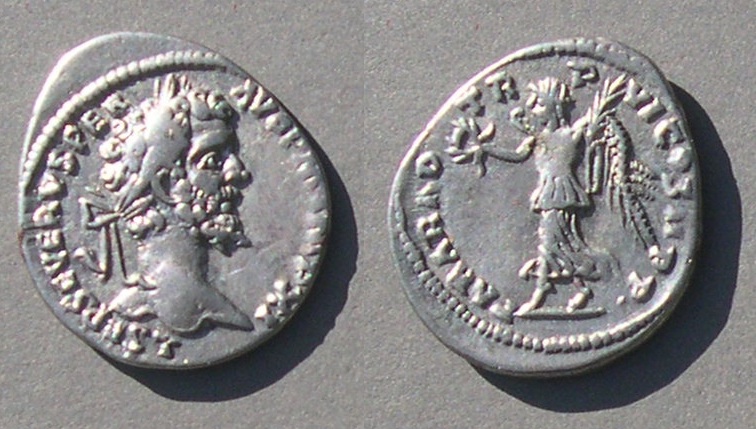 Septimius Severus, 193-211
Septimius Severus, 193-211
20-18 mm. 2.70 grams.
L SEP SEVERVS PER AVG PM IMP XI
Head right, laureate
PAR ARAB TRP VI COS II PP
"TRP VI" dates the coin to 198.
Victory advancing left with wreath and palm.
RIC 495. "198, Laodicea". Sear II 6321
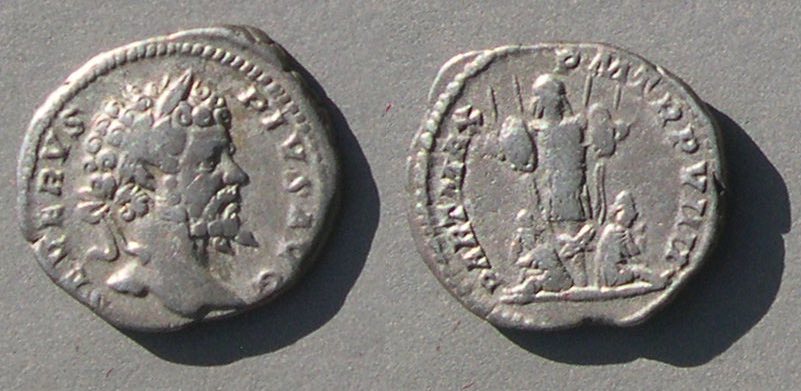 Septimius Severus, 193-211
Septimius Severus, 193-211
Denarius. 18 mm. 3.41 grams.
SEVERVS PIVS AVG
The title "PIVS" was assumed in 201
Head right, laureate
PART MAX PM TRP VIIII
"TRP VIIII" dates the coin to 201
RIC 176. Sear II 6323. BMC 259.
Some issues of Severus, like this one, were struck also for Caracalla.
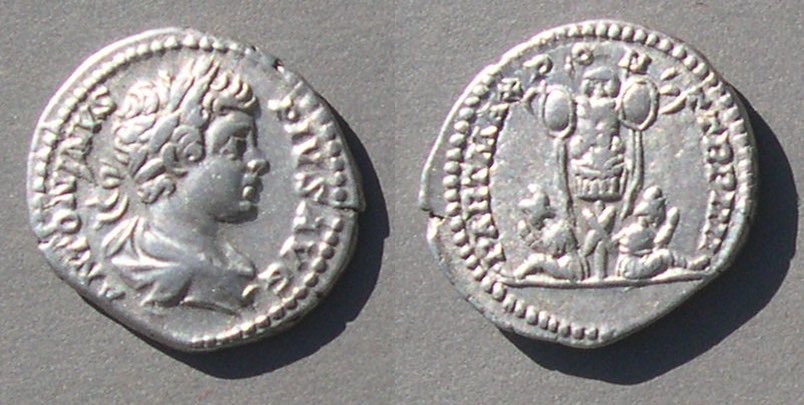 Caracalla
Caracalla
Youthful head right, draped and laureate.
[Type as above, issued by his father, except the TRP number belongs to Caracalla]
PART MAX PON TRP IIII
"TRP IIII" dates it to 201.
RIC Caracalla 54. BMC(S&C) 264. Sear II 6853.
 Septimius Severus, 193-211
Septimius Severus, 193-211
Denarius. 18 mm. 3.04 grams.
SEVERVS PIVS AVG
Head right, laureate
VICT PART MAX
Victory advancing left with wreath and palm.
RIC 295, "202-210". Sear II 6372, "Rome 204". BMC 365.
Struck 201-202.
Some issues of Severus, like this one, were struck also for Caracalla.
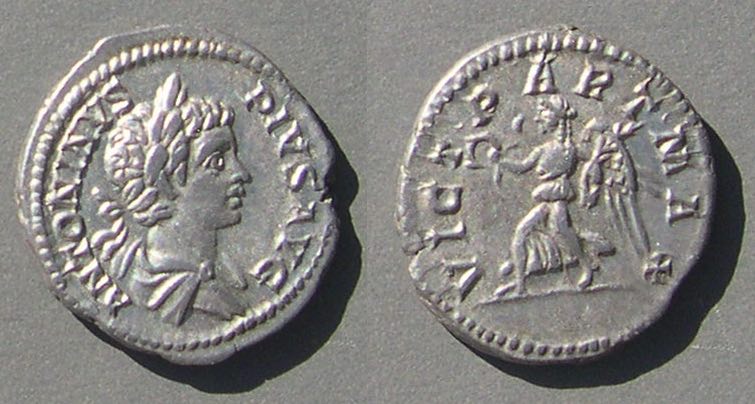 Caracalla
Caracalla
Denarius. 19 mm. 3.27 grams.
Youthful head right, draped and laureate.
[Type as above, issued by his father]
VICT PART MAX
RIC 144b. BMC 296. Sear II 6895, "Rome 204".
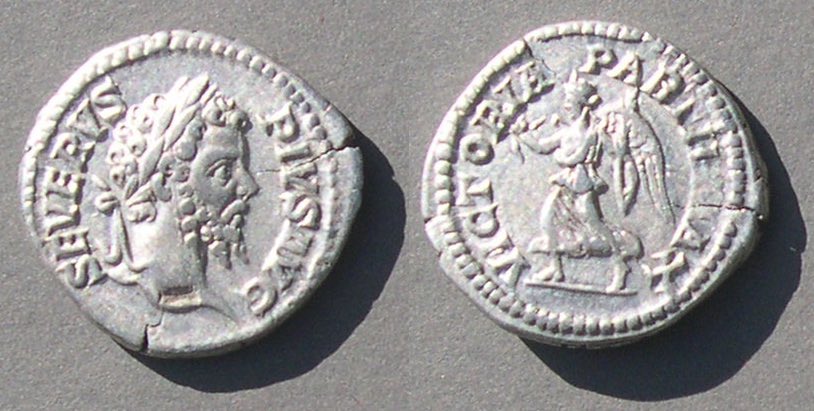 Septimius Severus, 193-211
Septimius Severus, 193-211
Denarius. 19 mm. 3.57 grams.
SEVERVS PIVS AVG
Head right, laureate
VICTORIA PARTH MAX
Victory advancing left with wreath and palm.
RIC 296. BMC --. Sear II 6379.
Very rare with VICT expanded to VICTORIA.
Some of the types found on denarii of Septimius Severus are also on other denominations.
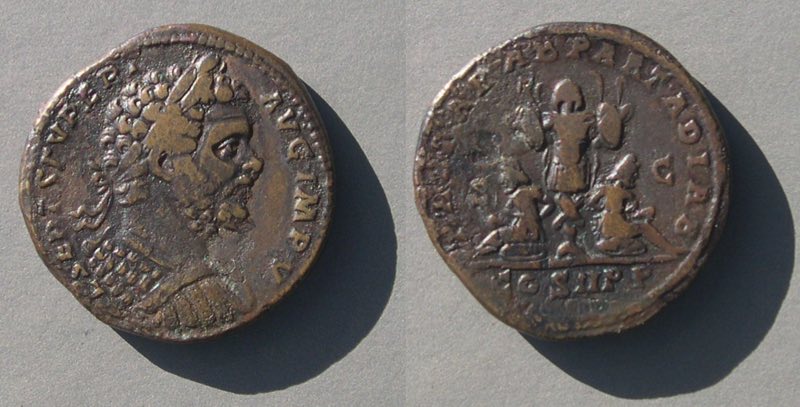 Septimius Severus, 193-211
Septimius Severus, 193-211
Sestertius. 31 mm. 26.76 grams.
L SEPT SEV PERT AVG IMP V
Head right, laureate.
PART ARAB PART ADIAB
COS II PP in exegue
Two captives, seated back-to-back, each on a shield
RIC 690b, "195". Sear II 6418. BMC 557, "195".
 Carrhae, Mesopotamia
Carrhae, Mesopotamia
14.3 mm. 2.07 grams.
Head of emperor right.
Crescent upright, head (of the moon goddess Sin?) within, crab? below, legend around.
The legend is difficult to read.
I think this coin is of Septimius Severus, but it is not on RPC on-line for anyone. The closest portraits are of Septimius Severus and Commodus.
Caracalla was Caesar 196-198 and Augustus 198-211. Caracalla was included in some of the Parthian victory issues of his father, Septimius Severus (above). Later, near the end of his sole reign, he had Parthian victories of his own. They are dated to his 20th year.
 Caracalla, sole reign 212-217.
Caracalla, sole reign 212-217.
Denarius. 19 mm. 2.78 grams.
VICT PARTHICA, Victory seated right on pile of arms, holding shield inscribed VO/XX.
RIC 314a. BMC 89. Sear II 6896.
Struck 217.
Caracalla introduced the larger "antoninianus" denomination, distinguished by the radiate crown, in his year 18 (XVIII). All of the Parthian victory radiates are from his year XX which was his last year, 217.
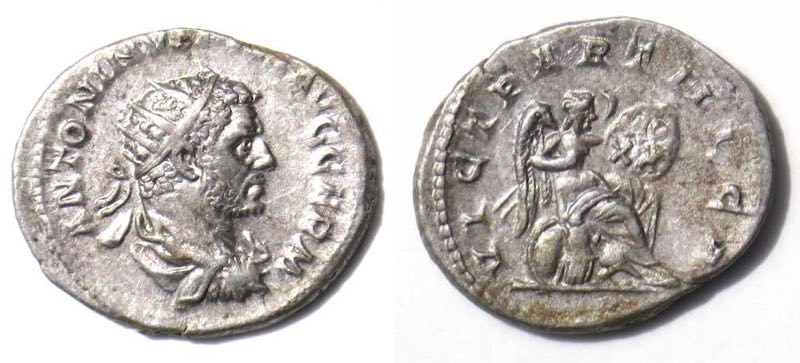 Caracalla
Caracalla
Antoninianus. 23-20 mm. 4.85 grams.
VICT PARTHICA
[The same design as above]
RIC 314b. Sear II 6788.
Struck year 217.
 Caracalla
Caracalla
Antonianus. 23-22 mm. 5.07 grams.
[The same design as the denarius on the main page.]
VIC PART PM TRP XX COS IIII PP, Emperor standing left, holding globe and short scepter, being crowned by Victory. Small captive at emperor's feet left.
TRP XX dates the coin to 217, his last year.
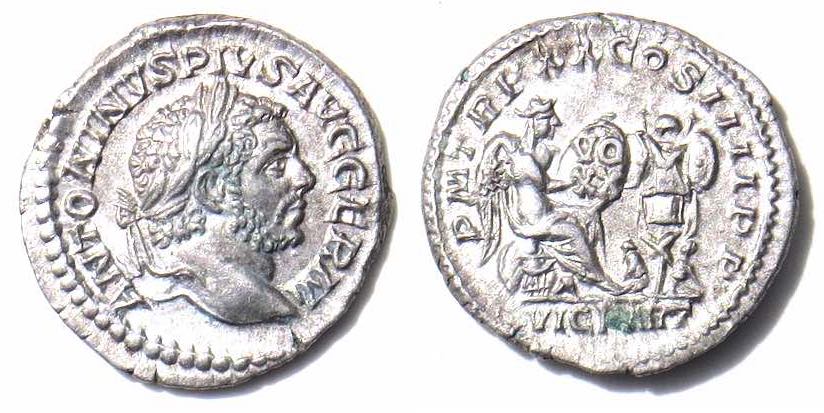 Caracalla
Caracalla
Denarius. 19 mm. 2.91 grams.
PM TRP XX COS IIII PP
Victory seated right on pile of arms, holding shield inscribed VO/XX, trophy to right with two small captives at is base.
VIC PART in exergue.
RIC 297e. BMC -- but there is an aureus and a radiate (next) of this design, 73.4-5. Sear II 6892.
Struck 217.
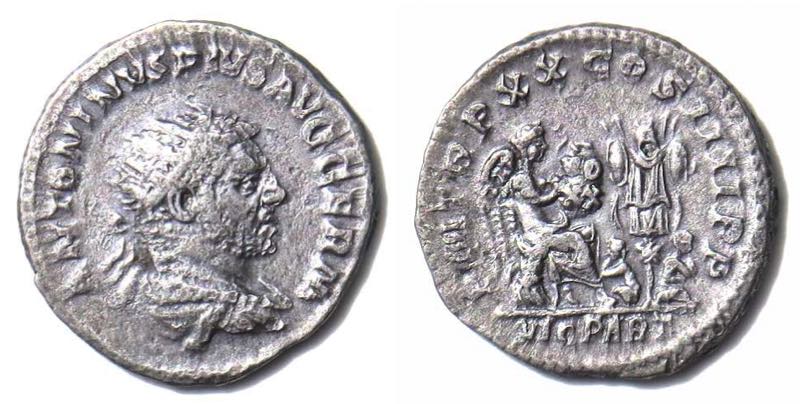 Caracalla
Caracalla
Antoninianus. 22 mm. 4.77 grams.
Bust right, radiate, draped, and cuirassed.
PM TRP XX COS IIII PP
VIC PART in exergue
[The same design as above, but on a radiate.]
RIC 297d. Sear II 6786.
Struck 217.
(Return to the main page.)
Marcinus (217-218) did not have an honest claim to a Parthian victory, but he made one anyway.
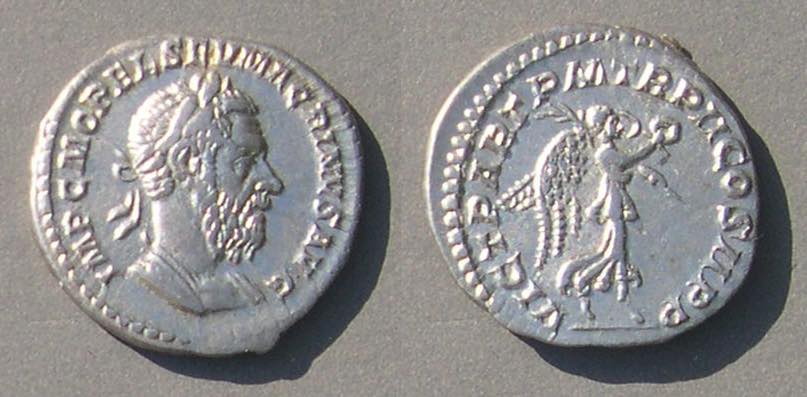 Macrinus, 217-218
Macrinus, 217-218
Denarius. 19 mm. 3.21 grams.
IMP C M OPEL SEV MACRINVS AVG
Bust right, laureate and cuirassed.
VICT PART PM TRP II COS II PP
Victory advanicng right holding wreath and palm.
RIC IV.II 49 "R". Sear II 7367.
(Return to the main page.)
Elagabalus (218-222), successor to Macrinus, is not noted in the literature as having a war with Persia and did not issue any imperial types alluding to a victory over Persia.
Severus Alexander did not have much claim to success in the East, but he did note his departure from Rome for the war.
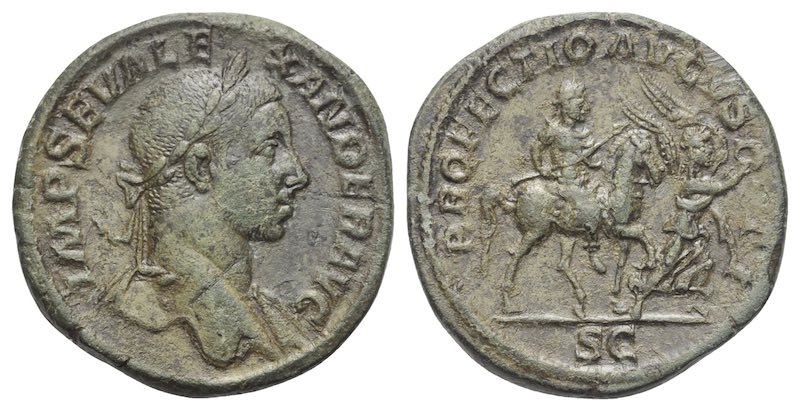 Severus Alexander, 222-235.
Severus Alexander, 222-235.
Sestertius. 30 mm. 21.68 grams.
PROFECTIO AVGVSTI
Severus Alexander departs Rome for war, led by Victory.
PROFECTIO means "Departure."
[PROFECTIO types are discussed further on this page.]
Struck 231. The type does not mention Persia but the timing is right for this to have been his departure for the East after Ardashir I (next, and coin) took Mesopotamia in 230.
(Return to the main page.)
Ardashir I (Artishir I) c. 224-242, the first Sasanian king.
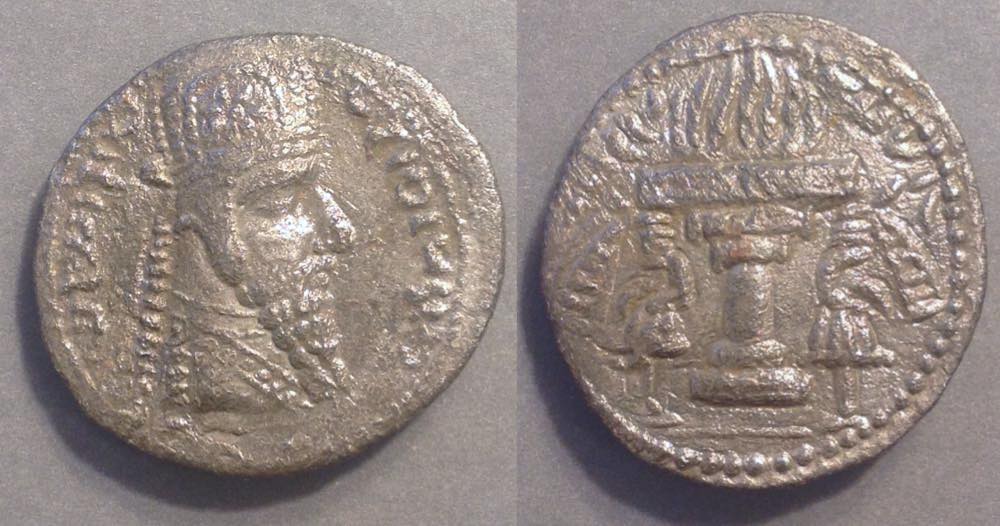 Ardashir I, c. 224-242
Ardashir I, c. 224-242
Base silver tetradrachm. 28-26 mm. 12.64 grams.
Flaming fire altar, censors below.
Sellwood 5.
Göbl plate 1.7
c. 230-231 Ardashir I took Mesopotamia during the reign of Severus Alexander. Roman provincial coins from northern Mesopotamian cities stop being issued and did not resume until the reign of Gordian III (238-244).
Karlson wrote, "probably made to meet the competition from the Syrian tetradrachms made by the Roman emperor Elagabalus."
Gordian III struck provincial coins at Nisibis and Singara.
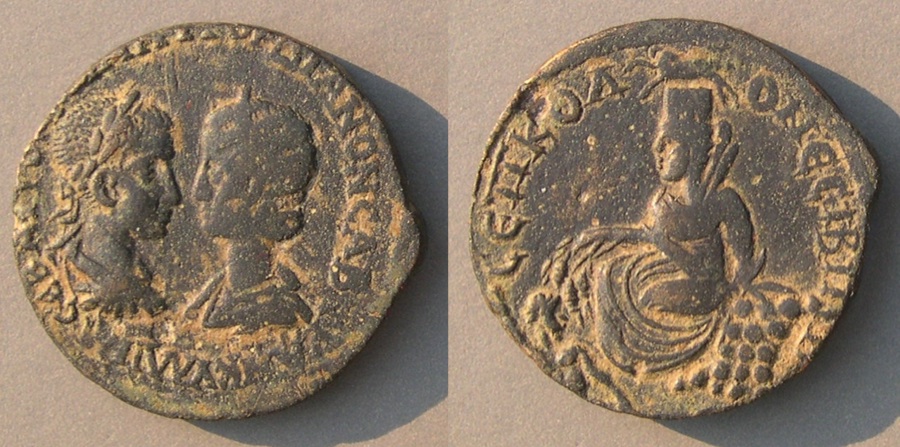 Gordian III, 238-244
Gordian III, 238-244
"Provincial sestertius." 32 mm.
Struck at Nisibis
Gordian III and Tranquillina, facing each other
(Beginning at 8:30)
AVTΟK K M AN ΓOPΔIANON CAB TPANKVΛΛINA CЄB
Turretted city goddess seated left on pile of rocks, holding ears of grain, small river god swimming left at her feet.
CЄΠ KOΛO NЄCIBI MHTPO
"CЄΠ" for Septimia, "KOΛO" for "colony," and "MHTPO" for "Metropolis" (i.e. the most important city in the region)
Sear Greek Imperial 3803.
Philip I, 244-249. Coins of Nisibis are common and mostly of the family of Philip. (Philip I from Nisibis is near the top of thε main page.)
 Philip II
Philip II
25-24 mm. 10.70 grams.
AVTOK K M IOVΛI ΦIΛIΠΠOC CЄB
(Autokrater Caesar Marcus Julius Philippus Sebastos)
Nisibis sometimes distinguished the two Philips by having Philip face right and Philip II face left.
IOY CЄΠ KOΛΩ NЄCIBI [1:00-3:00] MHT,
(Julia Septimia Colonia Nisibis Metropolis)
[This "Julia" is a family name for Philip.]
Tetrastyle temple containing statue of city goddess seated facing; above her head, ram (Aries) leaping right; below, river god Mygdonius swimming right.
RPC VIII on-line 2962 (temporary). Sear Greek Imperial 4157. BMC Mesopotamia Nesibi [sic] 21, attributed there to Philip I, with a footnote "Some of these may be of Philip Junior, especially nos. 21-4 on which the face appears to be beardless."
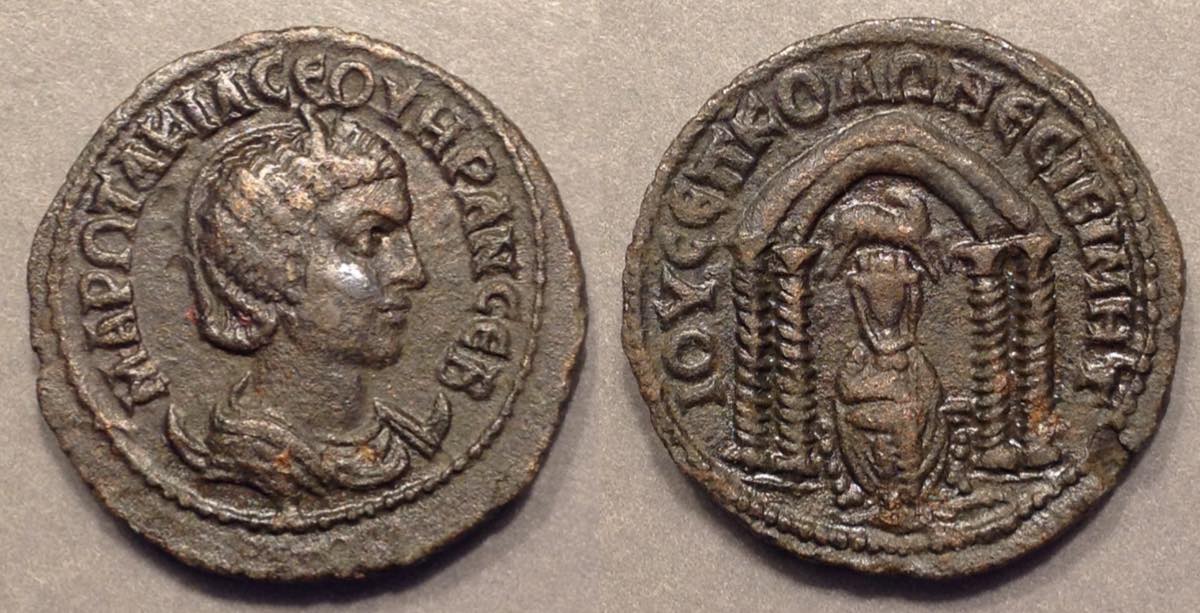 Otacilia Severa, wife of Philip I
Otacilia Severa, wife of Philip I
24.5 mm. 11.18 grams.
Also struck at Nisibis.
MAP ΩTAKI CEOYHPAN CEB
(Marcia Otacilia Severa Augusta)
Reverse as above
RPC VIII on-line unassigned ID 2575 as of August 2023.
For more about coins of Nisibis, see here.
Gallienus (joint reign with his father Valerian, 253-260 and sole reign 260-268) was included in the issues of Valerian that mention Parthia.
 Gallienus, son of Valerian.
Gallienus, son of Valerian.
22 mm. 3.79 grams.
Sole reign, 253-260.
IMP C P LIC GALLIENVS PF AVG
Bust right, radiate, draped, and cuirassed.
RESTITVT ORIENTVS
Turreted female standing right presenting wreath to the emperor standing left, holding a long staff.
This is precisely the same design and legend used on coins of Valerian (coin) and later on coins of Aurelian (coin).
RIC 448. Struck "253-254". Sear III 10381.
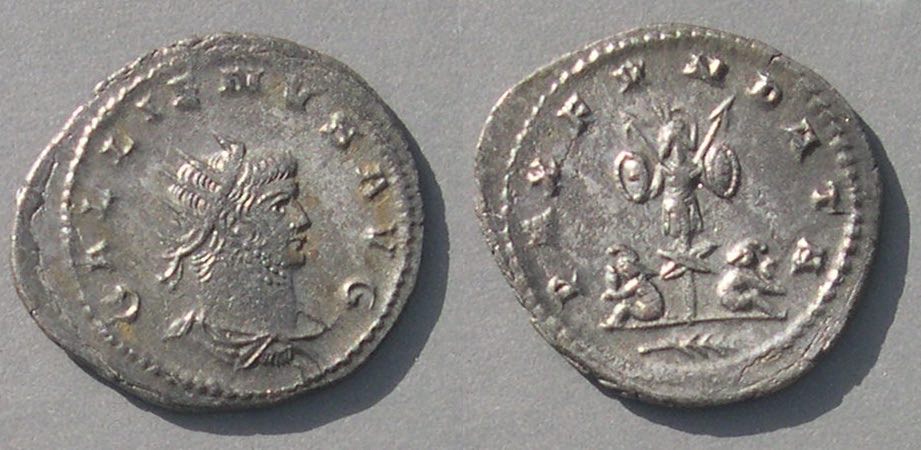 Gallienus, 253-268
Gallienus, 253-268
23-21 mm. 3.84 grams.
PAX FVNDATA
Trophy with two captives.
RIC 652 "mint of Asia" but undated.
Foss 52 says this is a reference to a peace settlement in 264 in the East "circumstances unknown"). The legend with the word "FVNDATA" which was explicitly used for a settlement with Persia by Philip I (coin) strongly suggests the reference on this coin is also to a settlement with Persia.
There is a rare legionary type (not illustrated here) of the sole reign of Gallienus with legend LEG II PART ... and a centaur as that legion's symbol.
Valerian II, the older son of Gallienus, also had Parthian victory coins issued in his name. Next is a type of Valerian (coin).
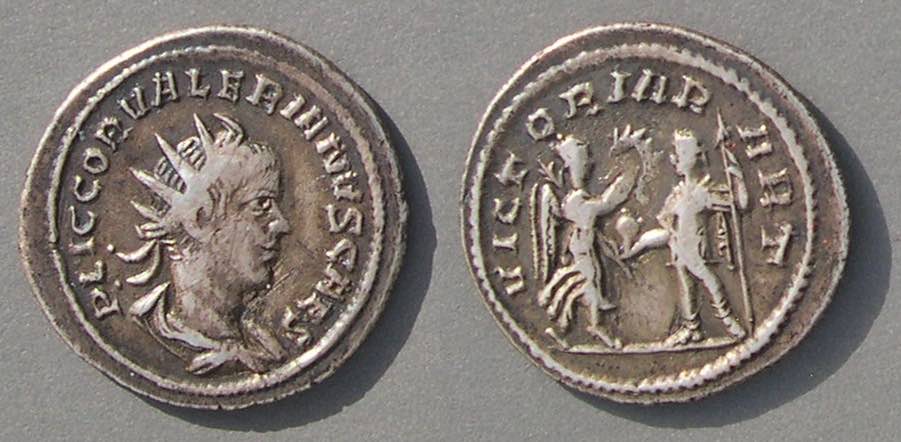 Valerian II, 256-258
Valerian II, 256-258
23 mm. 3.59 grams.
P LIC COR VALERIANVS CAES
Bust right, radiate, draped, and cuirassed, see very slightly from the rear.
VICTORIA PART
Victory holds a palm branch over her left shoulder and presents a wreath to the emperor who is holding a long vertical staff in his left hand
RIC 54. "255". Sear III 10792.
If the date is right Valerian was claiming a Parthian victory long before his disastrous loss to Shapur I in 260. That supports the idea that there were two campaigns, one at least partially successful c. 255 and then later, the famous defeat in 260.
Aurelian and Vablathus. Some tetradrachms of Roman Alexandria have Aurelian on one side and Vabalathus of Palmyra on the other.
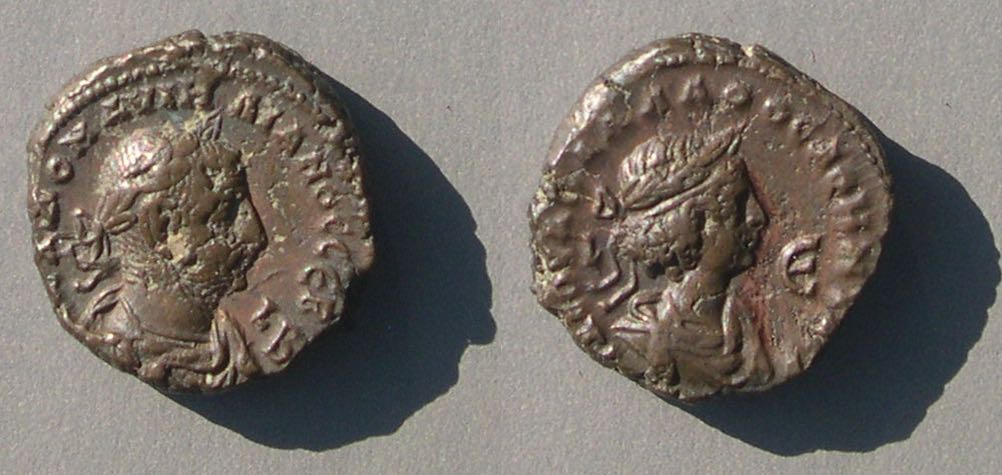 Aurelian and Vabalathus, 271-272
Aurelian and Vabalathus, 271-272
20 mm. 9.63 grams.
Tetradrachm of Roman Egypt struck at Alexandria.
AKΛ ΔOM AVPHΛIANOC CEB
Bust of Aurelian right
IAC OVABAΛΛAΘΟC AΘHNΟV...
Bust of Vabalathus right
Struck year 2 of Aurelian (LB) and year 5 of Vabalathus (LЄ).
Sear III 11721. Milne 4330. Emmett "270-271" 3914.
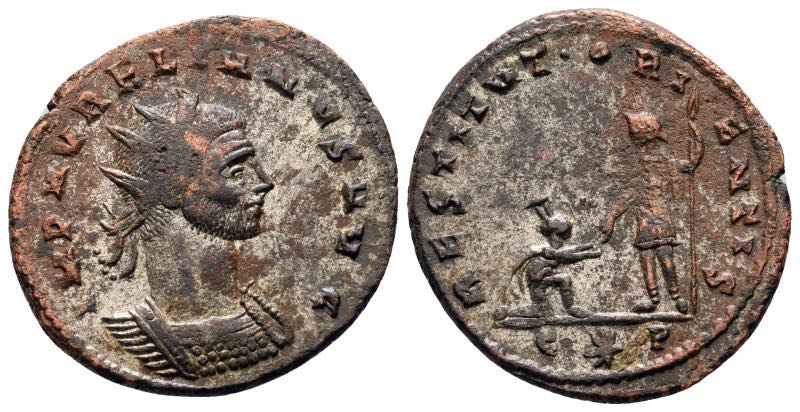 Aurelian, 270-275
Aurelian, 270-275
Antoninianus. 22-21 mm. 3.63 grams.
RESTITVT ORIENTIS
Emperor holding long staff and raising kneeling turreted figure
C*P in exergue
RIC 351, Cyzicus.
Sear III 11596 "Cyzicus, A.D. 272"
I interpret this as the cities in the East kneel in deference, appreciation, and thanks to the emperor who has restored them to the empire.
(Return to the main page.)
Carus, 282-284, died in Mesopotamia.
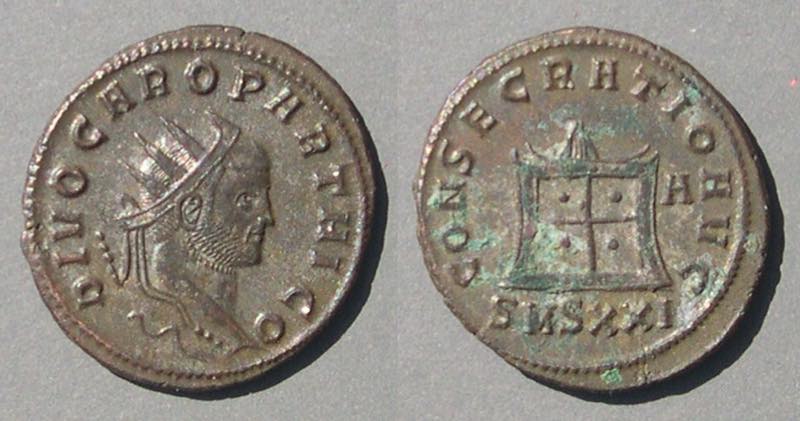 Carus, Posthumus, 285.
Carus, Posthumus, 285.
22 mm. 3.84 grams.
DIVO CARO PARTHICO
Head right, radiate.
CONSECRATIO around flaming altar
A to right and SMSXXI below.
RIC 111v "R". Sear III 12403.
The rulers we call Parthians were overthrown in 224 by the Sasanians, who were Persians.
Nevertheless, the Romans apparently still called them Parthians (in addition to calling them Persians) 60 years later.
(Return to the main page.)
Carinus and Numerian, 283-285. The only coin types from Roman Egypt that mention a particular legion are those of Carinus and Numerian that mention "Legion 2, Traiana." The type is not issued in the name of Carus, so it is after his death. It is not known why these types were issued. In this time period the location of this legion is not otherwise recorded. It is only speculation that this type might have something to do with the Persian war.
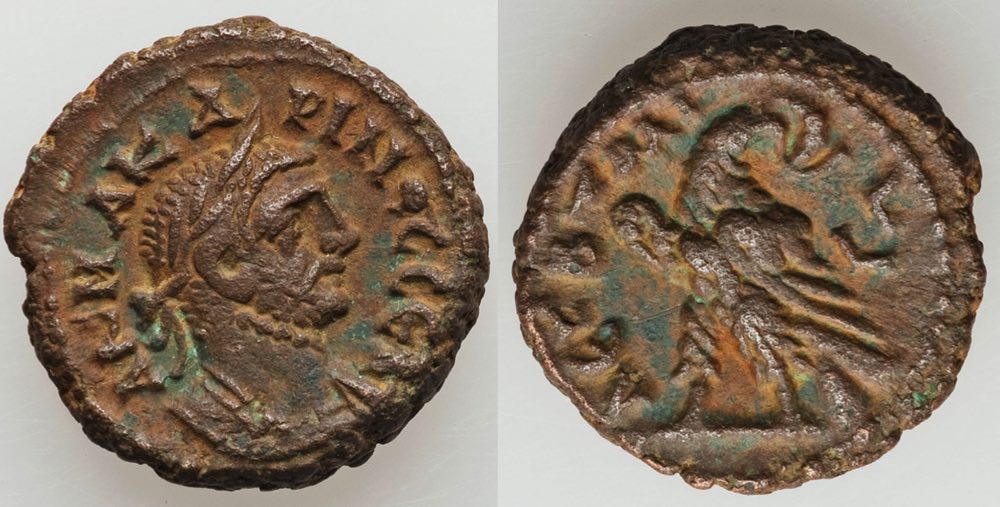 Carinus, 282-283-285
Carinus, 282-283-285
Tetradrachm. 19 mm.
ΛEG B TRAI
LΓ (year 3), late 284.
Emmett 4004. Sear III 12386.
Numerian, 282-283-284
Tetradrachm. 21-19 mm.
ΛEG B TRAI
LΓ (year 3) Late 284
Emmett 4017. Sear III 12279
(Return to the main page.)
Constantius II, Augustus 337-361, did not strike coins that mention Persia explicitly.
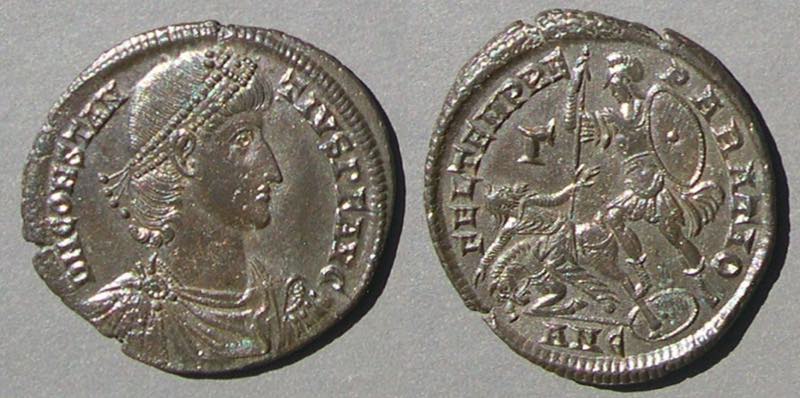 Constantius II, 337-361.
Constantius II, 337-361.
25-22 mm.
The coin does not mention Persians, but the reverse has a figure that reminds us of Persians. The soldier is spearing
1) a horsemen
2) who is bearded
3) and wearing trowsers
Except for the horse, he could be a northern barbarian, but the horse tips the identification toward a Persian.
FEL TEMP REPARATIO, soldier spearing fallen horseman
ANE for the Antioch mint.
RIC VIII Antioch 132. Sear V 18171.
Struck c. 348 in the coin reform. The other FEL TEMP REPARATIO types with captives lack the horse and are likely referencing victories elsewhere.
(Return to the main page.)
 Trajan, 98-117
Trajan, 98-117





























